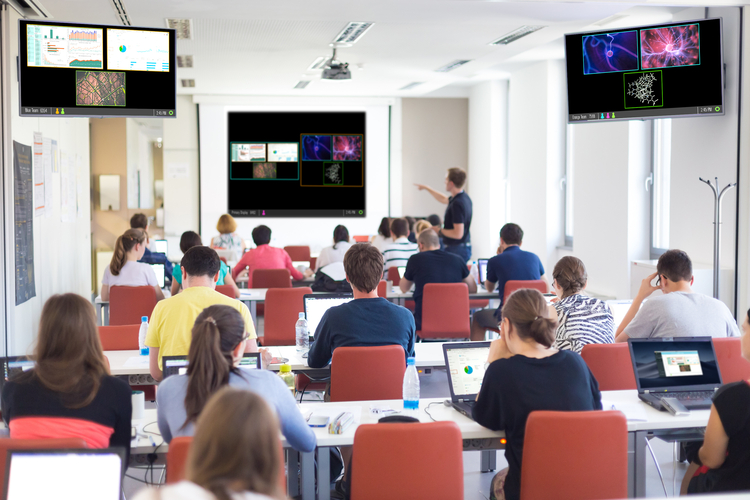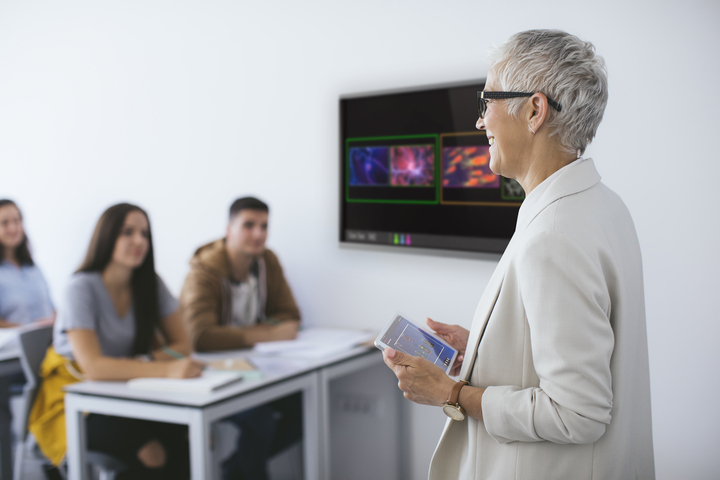You might not know that collaborative learning predates public schools. Many people believe it is a modern method of teaching that offers new benefits for students. But, educators have been using collaborative teaching techniques for thousands of years!
In their texts, the Greeks and Romans explain how important it is for students to learn from one another. They found that student performance increased when combining lectures with group activities.
If ancient civilizations understood the importance of collaborative learning in their classrooms, imagine how powerful the method can be in today’s higher education curriculum. Learn why the method is so important and how to apply it to your college classroom with our guide.

What Is Collaborative Learning?
Collaborative learning is a learning method based on student-centered learning, including group collaboration, team-based activities and discussion, and active learning pedagogy. Collaborative learning focuses on student-led discovery and learning.
Evergreen State College provides an excellent resource for the strategies and goals of collaborative learning. Rather than traditional, lecture-based instruction that often focuses on memorizing material, the collaborative method emphasizes engaging students through group learning. Students spend class time working together on group projects to learn the course material.
In collaborative learning, students use their different experiences, backgrounds, and perspectives, to collaborate and gain a greater understanding of the material. Often, educators also take part in the collaborative learning process.
Here’s an example of how collaborative learning might appear in a college classroom. First, students break into groups of 3 to 4 to discuss course work or work on assignments together. Next, the instructor may give students a short problem to solve together in a group setting. Students will discuss with each other how to solve the problem to find an answer. This group discussion and collaboration enables students to be exposed to various opinions, perspectives, and problem-solving strategies, leading to enhanced teamwork and collaboration skills and a better understanding of the material.
Some collaborative learning methods and exercises may include students defending their positions and reframing ideas. Students learn how to listen to others’ viewpoints and explain their own thought process and reasoning.
What Are the Different Types of Collaborative Learning?
By utilizing the strengths of each member of the group, students can learn in different ways. For example, during lectures, students will reinforce what they learned in group activities. Also, there are various ways professors can use collaborative learning within the classroom.
Different types of learning groups include:
- Think-Pair-Share
- Formal groups
- Informal groups
- Cooperative groups
Think-pair-share is one of the most common forms of classroom collaborative learning activities. Instructors will pose a question or problem to the class, allow time for students to evaluate the problem on their own and develop a position or response, and then pair or group students so they can discuss their answers and responses together. In a follow-up discussion with the full class, students can share their responses or may be asked if anyone changed their mind based on other students’ reasoning.
In formal groups, students will work together to achieve a common goal often over a period of weeks or months. A formal group has a routine and specific structure and roles that define the members’ responsibilities. In addition, formal groups have guidelines members follow to ensure the coordination of their activities.
The aim of an informal group is the same: to accomplish a single goal. However, compared to formal groups, informal groups are often more ad hoc and work on projects for a shorter period of time. During class time, informal groups can work together for ten minutes or more. The benefit is that students can discuss, explain, and integrate course material. Think-pair-share and group problem solving are examples of short-term informal group collaboration.
Cooperative groups, or collaborative base groups, are very long-term and provide consistent mentorship. Participants meet weekly for a period of between one and several years. The purpose of this type of group is to sustain academic progress for long periods. These groups often help students stay updated on missed lessons. It also allows mentors to address a students’ weakness in one area.

What Is the Benefit of Collaborative Learning?
As an educator, you might often hear how much your students dislike doing group work. This distaste for group work often stems from a couple of common issues. One reason students often dislike group work is due to procrastination by a specific group member or members. Another common challenge is working in groups with shy students or occasional personality conflicts.
Even so, there are benefits to students learning from group activities. Some benefits of collaborative learning include:
- Promotes a higher level of thinking
- Improves communication and leadership skills
- Provides exposure to different learning styles
- Increases students’ understanding of diverse perspectives
Researchers have also found that students perform better when working in groups. For example, students working in groups understood concepts more deeply than those who didn’t.
Collaboration also provides social skills necessary for future professional success.
What Are Some Collaborative Learning Strategies?
Sometimes it’s hard for educators to increase students’ engagement in the classroom. So, here are some suggestions to facilitate a collaborative learning environment.
Collaborative Learning Technology
In an active learning environment, technology can help students collaborate. Also, the use of technology helps students develop critical thinking skills.
Here are a few ways an instructor can apply cooperative learning technology:
- Communicate via text, voice, and video in real-time
- Provide essential project management support
- Enable classroom collaboration through content sharing technology
- Facilitate co-creation via real-time or asynchronous group editing
- Organize group discussions and polls to support consensus building
- Support team-table based active learning with active routing technology
- Present and archive projects
Creating an active learning environment is crucial for students and professors today. Individuals can do this with the help of active learning technology. Intuitive active learning software enables students at team tables to easily share, control, and mark up content from their personal devices to a team table display. Educators and classroom facilitators then have the ability to flexibly route video feeds between displays in the room to enhance learning among the student groups.
Effective active learning technology also includes powerful student-teacher engagement tools, such as customizable on-demand messaging so facilitators can easily communicate with students and guide them through lesson plans.
As a result of active learning technology, students also develop creativity and critical thinking skills and maintain their concentration. The wireless content-sharing technology allows students and educators to BYOD (bring your own device) so that everyone can share and collaborate using the devices they are the most familiar and comfortable with, an essential requirement for technology use in higher education environments.
What Are Some Student Engagement Strategies?
It can be challenging for professors to break the ice with group work at the beginning of a semester. Here are some ways to increase student engagement in a college classroom.
Discuss the Use of Collaborative Learning Early
As the professor, you should tell your students that you will be using group work methods in the course. Then, students will know ahead of time how group work will benefit them.
They also know they must engage with their classmates on assignments. When students see the use of collaborative learning in advance, they will be more likely to gain more from it.
Establish Rules for Group Activities
Professors should teach students group rules to avoid future disagreements or shyness. Below are some expectations to set for collaborative learning:
- Be respectful of each other
- Everyone is assigned the same number of tasks and/or amount of work
- Make sure everyone has an opportunity to voice their opinions and concerns
- Embrace others’ ideas and be willing to cooperate with them
- Give ideas a try, even if you dislike or disagree with it
- Be a good listener
- Don’t criticize
- Attend all group meetings and be on time
- Schedule meetings to ensure you can accommodate everyone’s schedules
Students are held accountable to the group rules and a safe learning environment is in place. Setting group rules requires honesty about what everyone wants and expects. The rules also allow students to understand what everyone can contribute.
At the beginning of a project, everyone should agree on the rules. Then, it is the students’ responsibility to hold one another accountable for broken rules and determine the consequences.
Professors Engage With Students to Develop Group Skills
When professors have students conduct group work, it’s vital for them to offer assistance. Sometimes students may struggle to present their ideas to their classmates. Below are some of the ways educators can help improve students group skills:
- Facilitate interaction by having students introduce themselves to their group
- Break the ice by making group activities into games
- Enable groups to be creative in their problem solving methods and solutions
The goal of team-building activities is to encourage communication between teammates. As students gain confidence in interacting, they’ll start to share ideas. Through confidence, students are more willing to participate in group projects.
Include Peer Assessment for Collaborative Learning
Peer review helps students see the connection between their knowledge and their coursework. In doing so, they engage with their coursework differently. Therefore, students can learn how to reflect upon their work as critical thinkers.
As a result of peer review, assignments can become more collaborative. It allows students to share knowledge and reflect on the coursework. Rather than responding to questions, the students become lifelong thinkers.
Encourage Group Collaboration With Social Media
Students spend a great deal of time on social media channels. Think about ways in which you can incorporate classroom learning using social media platforms.
Social media gives learners direct access to relevant content to share. For example, students can find insightful discussions on TikTok for a popular video. Be aware that, due to safety concerns, you may need to institute some ground rules and be sure to adhere to institutional policies.
Embrace Diversity
Collaboration and learning are impossible without diversity. Research demonstrates that a diverse classroom is beneficial for everyone. Diversity invites people from different backgrounds to interact without judgment.
In such spaces, students learn perspectives from others that they might not otherwise have been exposed to. People also learn to respect others when they share and understand their opinions.

Start a Free Trial to Boost Collaborative Learning Today
A collaborative learning environment can increase your students’ productivity and education. Students also learn essential communication skills and work ethic. These skills are crucial to future success in the workplace and will provide a foundation to help students succeed in academics and their careers.
Interested in learning more about technology that can support collaborative learning?
Request a live demo of Solstice Active Learning for collaborative learning in your classroom today!
